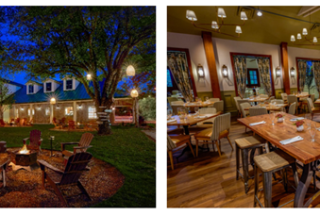Holland, MI – One of the more challenging projects in the career of Michigan golf architect Raymond Hearn has been recognized as one of his most remarkable achievements. Hearn’s remake of the classic 110-year-old Flossmoor Country Club in suburban Chicago was selected as the 2009 Renovation of the Year by Golf Magazine, one of the game’s leading publications.
In announcing the award, Senior Editor Joe Passov wrote that Hearn’s “inspired renovation has put the storied club back on the map.” The prestigious award was published in the magazine’s January issue featuring an annual review of the best golf courses in the country.
Earlier in its history, Flossmoor, designed by Herbert J. Tweedie, consistently hosted major tournaments, including a PGA Championship in 1920, five Western Opens, five Western Amateur Championships, and two USGA National Championships. The course was a favorite of the legendary Bobby Jones who was a runner-up for the 1923 U.S. Amateur title won by Max Marston.
Over the past century however, the greens and bunkers shrunk, and hundreds of trees narrowed the fairways, relinquishing strategy and playing options Tweedie had created in his design.
Hearn was hired to restore and update the course three years ago. Golf critics as well as members and officers of the club agree that he not only brought the course back to golf’s “Golden Age,” but he dramatically modernized and improved the layout.
Tackling a historic course more than a century old was a daunting assignment, Hearn acknowledges.
“It was a great challenge because you want to respect the history and tradition of the course and I did a lot of research on Hebert Tweedie,” Hearn said. “What was daunting about it is adapting the course to what technology is doing to the game.”
As technology has produced lively clubs and balls that have rendered older classic courses obsolete, architects have not always responded favorably.
“You look at what’s been done to the Holy Grail of golf, the old Course at St. Andrews, lengthening it, adding bunkers, to where it almost seems that technology and tradition cannot harmonize,” Hearn said. “They almost seem diametrically opposite of each other but yet I felt it could be done.”
Hearn said one key element to the renovation was Tweedie’s original routing of the holes. It had survived nearly intact despite earlier remodeling by other architects.
“What I wanted to do was look at technology where golf balls and golf clubs have rendered obsolete hitting distances from all the varying tee boxes and try to really put the spirit back into the risk reward scenarios,” Hearn said.
To accomplish that goal he had to convince club officials that he needed to remove 1,200 trees. He also proposed replacing bland round bunkers with lace-edged ones similar to those at the Rivera Country Club in Los Angles that were created by iconic early 20th century architect, George Thomas.
“Prior to the tree removal the strategy was hit it as straight as you could down the center of the fairway and hope you don’t go off to the sides of the fairways where the tree lines will get you, the common pitfall of many old classical golf venues,” he said. “So we removed the trees and restored some of the old classic Tweedie risk-rewards.”
In addition to redesigning the bunkers, Hearn redesigned fairway and approach limits, added new tees and restored original green boundaries. He added 15 new bunkers, and repositioned others for strategic reasons. He also earthed and restored seven old bunkers, mostly for aesthetics and as a tribute to Tweedie.
“The new bunkers and new tees make it happen in term of modern day risk reward,” Hearn said. He complimented the progressive membership that gave him a free hand to make the changes.
Club’s historian, Greg Ohlendorf, praised Hearn for his respectful approach to Tweedie’s design and concepts.
“The last thing we wanted to do was to have someone come in and fix something that didn’t need too much fixing,” Ohlendorf said. “Ray brought back the angles and lines of play that had been lost and he did a masterful job.”
Ohlendorf and Hearn singled out Mark Egge, the club’s greens chairman, for helping sell the drastic changes to the membership, and Bob Lively, the club’s superintendant with did the finishing work.
“In the 25 years that I have been in the business, I have worked with a number of golf course architects on many various projects, and after finishing three years working with Raymond Hearn Golf Course Designs I could not be more pleased,” Lively said,
“We chose RHGCD because of Ray’s expertise in classical course restorations and his “lay of the land” minimalist approach to golf course design, which fit the criteria that we were looking for in a golf course architect. We are extremely pleased with Ray’s outstanding restoration and remodeling design,” he said.
Working at Flossmoor held a special caveat for Hearn. It was on that course that the famed Chick Evans won his first amateur title in 1916. Evans went on to establish the Evans scholarship that over the years has provided college educations for thousands of golfing youngsters. Hearn is one of the few Evans scholars who are golf architects.
Hearn is in his 25th year as an architect and is the principal of Raymond Hearn Golf Designs. Inc. based in Holland, Michigan. The firm has won numerous national and international awards for its new course designs in nine states in the United States and abroad in France, South Korea, Vietnam, Egypt, Russia, India, and the Bahamas. The firm has also completed 30 acclaimed renovations of older courses.
Hearn conducts seminars in which he teaches classic golf course design for students, professionals and golf enthusiasts. He has also lead student groups on field trips to study the old courses in the British Isles.
For more information, visit www.rhgd.com.
Contact:
Covering the business of golf!



